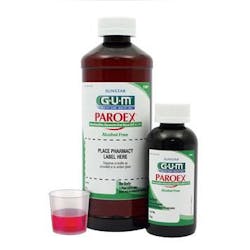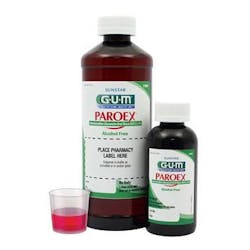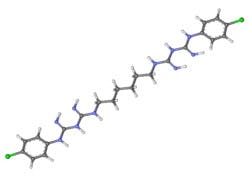Update on chlorhexidine
Mechanical instrumentation, such as scaling and root planning, is an effective method for removing supra and subgingival bacterial biofilm on tooth surfaces, as well as reducing probing depths. It also creates noticeable changes in the subgingival bacteria to sustain a microflora indicative of periodontal health. It does not eliminate all of the periodontal pathogens, due to a number of factors.
Up to 30% of the total surface area of treated roots can be covered with residual calculus following subgingival scaling and the bacterial re-colonization of the root surface by pathogenic bacteria may lead to periodontal disease recurrence.(1)This is one reason the use of adjunctive antibiotics and antimicrobials have been tested and reported in the literature.
Chlorhexidine is available in three forms: the digluconate, acetate and hydrochloride salts. Most oral formulations use the digluconate salt that is water-soluble, while hydrochloride is very sparingly soluble in water. A study conducted in Italy was a preliminary case series with a small sample size and short follow–up.(3)
The objective of the case series was to evaluate the clinical and microbiological effects of a single session of mechanical and manual scaling and root planing (SRP) combined with the use of two different chlorhexidine formulations in the treatment for generalized chronic periodontitis. Ten patients with chronic periodontal disease and periodontal probing depth (PPD) ≥ 5 mm were treated with SRP plus local chlorhexidine. In each patient, similar teeth, treated with SRP with the adjunctive use of chlorhexidine digluconate and dihydrochloride or chlorhexidine gluconate, respectively, were selected and assigned to a test and a control group. In both groups, PPD, bleeding on probing (BOP) parameters, total bacterial counts (TBC) and quality of periodontal bacteria at time 0 and 6 weeks after treatment were measured.
The results showed that PPD significantly decreased over time both in the test and in the control group. There were no significant differences observed between the two groups. BOP and TBC were significantly lower in the test than in the control group six (6) weeks after treatment. In the post-treatment revaluation, a significant decrease both in the treatment and in the control group, for each of the single periodontal pathogens, was observed.
The authors concluded that while there was a small sample size and short follow-up in this study, it showed that the adjunctive use of chlorhexidine (CHX) to SRP resulted in clinical and microbiological benefits in the treatment of generalized chronic periodontitis. A CHX gel formulation consisting of CHX digluconate and CHX dihydrochloride appeared to lead to additional benefits over SRP plus CHX gluconate in the short term. Additional investigations are needed to evaluate the effectiveness of this antimicrobial therapy.
References
1. Petersilka GJ, Ehmke B, Flemmig TF. Antimicrobial effects of mechanical debridement. Periodontol 2000 2002; 28: 56–71. Review.
2. Todkar R, Sheikh S, Byakod G, Muglikar S. Efficacy of chlorhexidine mouthrinses with and without alcohol - a clinical study. Oral Health Prev Dent. 2012; 10(3):291-6.
3. Calderini A, Pantaleo G, Rossi A, Gazzolo D, Polizzi E. Adjunctive effect of chlorhexidine antiseptics in mechanical periodontal treatment: first results of a preliminary case series. Int J Dent Hygiene, 11, 2013; 180–185.



